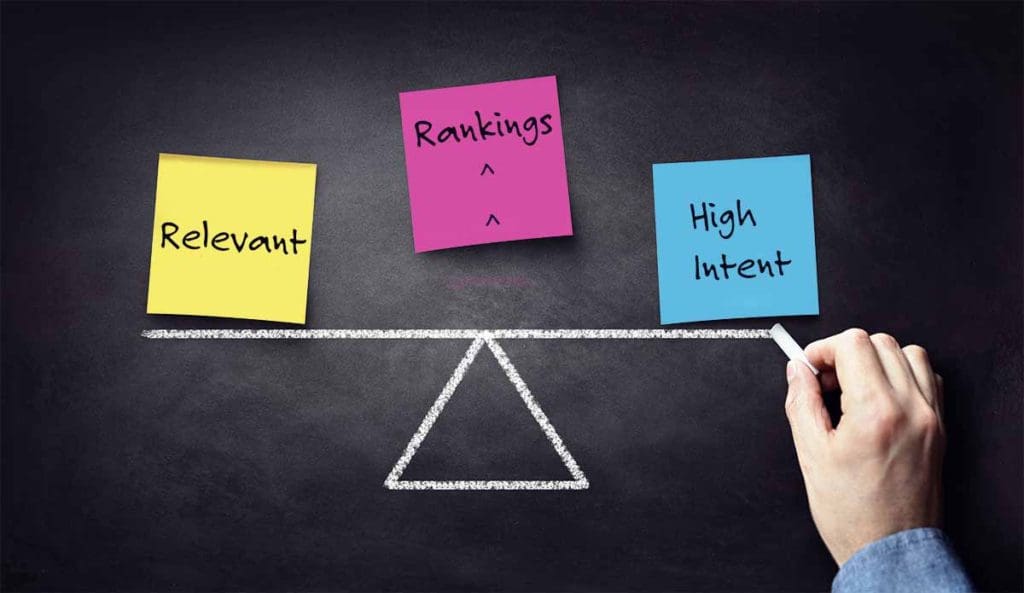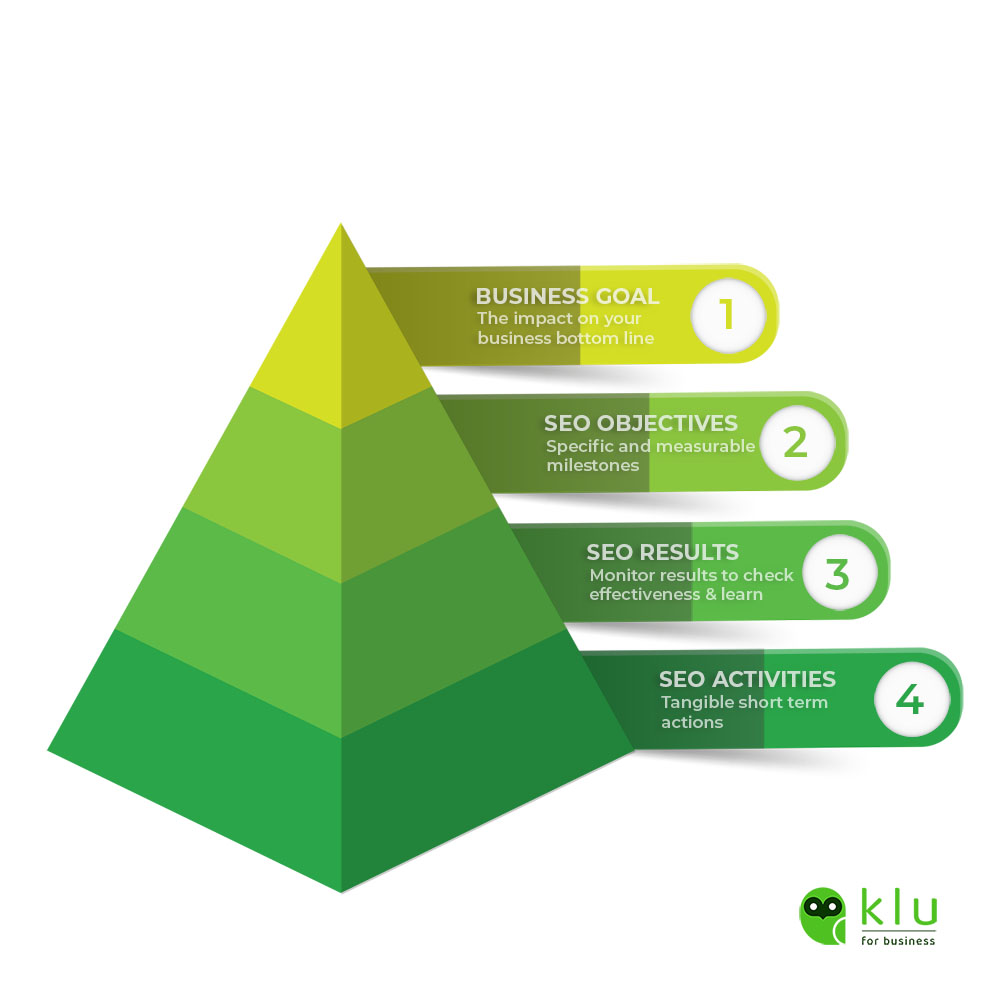How to set SEO goals for your business
Many business owners only discover SEO when they’ve exhausted other ways of increasing their website traffic. At this point, anything can happen and for many, it can be a frustrating endeavour. Unless you are quite clear in what you are trying to achieve, you can get everything you wish for, but to no actual effect. To get the best results, it’s vital to know where you’re starting from and concentrate your efforts where they are going to make the biggest difference. This post aims to help you identify what it means for you when you are setting measurable SEO goals.

Table of Contents
What are search engine optimisation goals?
Search engine optimisation (SEO) goals are the starting point of your SEO strategy; they set the direction of travel and identify the outcomes that you want to achieve within a set time. If you’re still trying to work out where SEO might fight into your business strategy, check out Which is better – paid search or SEO? for some pointers.
People will tell you that you need to create blog posts, or in other words, ‘produce more content’. For sure, this can be a very effective way of increasing website traffic; but without a robust SEO strategy, it can also be a complete waste of time. SEO is a long game, so you can spend an awful lot of time and effort experimenting if you’re not careful. On the bright side, get it right and reach the tipping point, you’ll be able to compete for high-value organic search traffic much more easily. Once you reach that point, (and it may be a lot easier than you think!) you will have a pipeline of potential new customers and have reduced your reliance on paid search forever.
Organic search still generates around 51% of all traffic to websites, so it’s not something to brush over if you want to get your products and services in front of potential new customers every single day.
Your SEO lightbulb moment
So you’ve had your first SEO lightbulb moment and it can be tempting to jump right in and get busy. Plenty of people do just that. But SEO strategies are no different to any other business strategies; I can’t emphasise enough how important it is to identify your current position in relation to your SEO goals and objectives before you do anything else. If you’re really new to SEO strategy or paid search advertising, the SEO questions you are faced with might seem a bit odd.
Surely the SEO goal is organic traffic, right? I mean if you want customers, you need traffic. If you want leads, you need traffic. And if you want people to call you, you need traffic. And when you have no website traffic, getting traffic can seem like the only problem worth solving.


Not all website traffic is equal
The idea that all website traffic is equally good is an all too common pitfall. Unfortunately, there are plenty of people making money out of it – those people are just unlikely to be you. Those people that get you all the great backlinks? Them. The people that will get you your first 1,000, 5,000 or even 50,000 web visitors? Them too.
Not only are these types of tactics potentially harmful to your SEO in the long run, if you use them as the basis for a paid search approach, you’ll be throwing money down the drain into the bargain.
The extent to which you are able to gain useful insights from your data to inform your SEO goal setting and measurement depends upon where you currently are in your journey. You can’t gather visitor experience or satisfaction data if you simply have no visitors. The approach below starts from a low visitor base looking to increase brand awareness. At the other end of the scale, there are the sites able to gain insights from low numbers of existing traffic to drive improvement.
Types of organic search traffic
Companies like Google, Bing and others analyse the behaviour of literally billions of internet search queries every day. This means that search engines such as Google can differentiate search traffic by quite accurately predicting what the searcher intends to do next, irrespective of what they actually type in the search box.
This is how they ensure that they send the most valuable traffic to the websites that are most likely to meet the needs of the searcher. It’s also how they can create a bidding war for particular segments of traffic in the paid search arena. In general, when it comes to organic searches, search engines will match the quality of your site to the ‘value’ of the searcher. This process can be extremely competitive when it comes to valuable high intent organic search traffic. High intent traffic would be where the search engine anticipates that a purchase, booking or other types of conversion is imminent.
Let’s break down your possible organic website search traffic into three broad segments to illustrate.
How irrelevant traffic affects your SEO targets
Low relevance or irrelevant traffic is traffic that you might get to your website on the basis of a search that is only remotely or not at all related to your business or business objectives. So, for example, if you sell ice cream, people researching a recipe for deep-fried ice cream are really of little value to you. Firstly, they are unlikely to ever buy your ice cream. More importantly for SEO and search engine rankings, if for some reason they do visit your site, they are likely to leave almost immediately. This ‘bounce’ is a negative signal to search engines and will make it harder for you to rank in the longer term.
There are a number of reasons that you might end up with this kind of traffic, but generally, it relates to poor keyword targeting, either intentional or accidental. If you consider paying for an SEO service, you should ensure that these keywords are given lower priority (if any) in results terms; they may be attractive, because they will often be easier to succeed at quickly, but they will contribute little to your overall objectives. You can save time and rank faster by avoiding common low competition keyword traps.
How low value but relevant traffic impacts your SEO goals
The value of traffic is generally related to search intent. Low value traffic may serve many purposes, but a low value traffic, based on search intent is unlikely to buy something or book you. Low value but relevant traffic is traffic whose interests are closely related to your business or related businesses but their search intent suggests they aren’t about to commit. Imagine you are a dressmaker who alters wedding dresses. People that are searching for wedding dresses may not actually be looking for you right now, but being seen by those same people is valuable for raising your brand profile in the same kind of buying circle. The key difference between low relevance and low value but relevant organic traffic is that this type of organic traffic may be interested in your core product or service sometime in the future.
As with low relevance traffic, the people who do visit your site must find what they are expecting and stay as long as possible. Bringing these visitors to your site under false pretences is counter-productive, but attracting these visitors with cross over content such as “7 bespoke alterations every wedding dress should have” is likely to have value in the medium to long term. Initially, this will benefit general brand awareness and familiarity but may lead to conversions or referrals much later.
How high value and relevant traffic benefit your SEO rankings
High value and relevant traffic is the most desirable search traffic to capture. It is search traffic that is closely matched to your business offer (relevant) and is highly likely to buy or call you as a result of a visit to the site (high value). So in this case, if you make personalised shirts, a searcher that typed “buy personalised shirts online” into a search engine would be likely considered high intent traffic. The reality is that the vast majority of Google search traffic goes to the top 3 rankings spots.
However, if your site is currently receiving very low traffic, even if you only achieve moderate ranking in the short term, even a handful of very high-quality visitors will create incremental improvements in both traffic and conversions. It is even more critical that these searchers have a good on-site experience and find what they are looking for. As a small business website, trying to game the system by optimising for something you don’t actually offer just to drive traffic could be catastrophic.
Assessing the current SEO status of your website
SEO goals and performance indicators for a newer site
It is typically challenging to make SEO gains on a newly registered domain. Depending on the size of your website and the competitive landscape, it can take at least 6 months for Google, in particular, to ‘trust’ your site sufficiently to send any traffic your way at all. This is no reason to lose heart though. The sooner you begin, the sooner you are going to reap the benefit. So let’s imagine you have a newer website, a number of competitors in your area and you are currently generating an average of 0-10 organic visits per month. You are very unlikely to rank in the short to medium term for any high-value traffic.
Priority SEO tasks
Your first priority SEO focus should be to ensure that your site has a solid technical SEO foundation and you are following established best SEO practices. You should aim to create new content and optimise your early blogs and other non-core pages to compete for lower intent, but relevant audience segments. This will ensure that any inbound traffic signals to search engines that the site offers a good user experience which will boost your site authority factors over time.
Consider creating good quality blog articles that provide up to date information or a unique perspective on frequently searched topics and popular questions that are closely related to your field, even if they aren’t directly related to the service you offer.
SEO goals and measurement
Your main SEO goals will be around creating brand awareness and a positive user experience. You may initially measure your progress by monitoring the number of views, site users, pages viewed and bounce rates. It is important to differentiate your traffic channels since your SEO goals are most concerned with the effect on your organic traffic.
You may wish to supplement your efforts with relatively low cost paid search campaigns. You may also wish to consider higher value campaigns once your technical and on-page SEO is of a reasonable standard. Be sure to direct traffic from your social posts and campaigns to your website when it is appropriate, but bear in mind you need to differentiate these visitors in your results. It is likely to be 6 – 12 months and possibly even longer for a very new site before you see a significant positive impact. However, once the ball starts rolling, you will be in a very strong position to rapidly expand your audience.

Irish small business indicative website performance benchmarks 2021 (Google Analytics)
Organic Traffic
Social traffic
Paid Traffic
Average sessions per month 154
Pages viewed per session 2.43
Time spent 1:54 minutes
Bounce Rate: 56.31%
Average sessions per month 123
Pages viewed per session 1.59
Time spent 38 seconds
Bounce Rate: 71.79%
Average sessions per month 149
Pages viewed per session 1.52
Time spent 35 seconds
Bounce Rate: 77.71%

SEO goals and performance indicators for an older underperforming site
If you have a site that is more than 12 months old with a number of pages and an active blog but is only getting 10-20 organic searches per month, your approach will be slightly different.
Check the foundations of your site
Initially you should give your technical SEO a workout to make sure that there are no underlying technical SEO issues that are preventing your site from being indexed or shown in search results. If all your technical SEO bases are covered, you can move on to on-page SEO optimisation. Review your keyword research and competitor analysis and make sure your content is broadly optimised to attract the audience you want. Making a positive impact and getting sustainable results can still take some time if you are starting from scratch or you’re working in a particularly competitive market.
Does your content resonate with your audience?
Check how your current traffic aligns with your ideal audience and monitor how they behave when they get to your site. Do they originate from your target geography? How long do they stay and how many pages do they view? You should be in a position to identify some keywords that have higher ranking potential; these are words that are already registering with search engines, but still in a weak position. Although your search volumes are low, there may be some clues here as to how you can better target your content or improve your user experience.
What can your conversion rates tell you?
Finally, you need to analyse your current conversion rates if relevant. It is important to manage your conversion rate expectations in line with your industry benchmarks. Bear in mind that depending on your business sector and the function of your website, it may be difficult to track website conversions very closely just by using traffic analytics alone. If your site has no major usability issues, relatively minor tweaks to improve on-page optimisation can result in quite a dramatic rise in organic traffic search traffic within 2-4 months.
Irish small business indicative website performance benchmarks 2021 (Google Analytics)
FLORISTRY
Organic Traffic
Social traffic
Paid Traffic
Average sessions per month 143
Pages viewed per session 5.20
Time spent 3:33 minutes
Bounce Rate: 38.89%
Average sessions per month 112
Pages viewed per session 2.06
Time spent 46 seconds
Bounce Rate: 59.10%
Average sessions per month 183
Pages viewed per session 5.07
Time spent 3:32 seconds
Bounce Rate: 36.49%
SEO goals and performance indicators for a more established site
If your site is more established and you are receiving 20-40 organic searches per month, after reviewing your technical SEO health, you should focus on the sources and behaviour of your existing organic traffic for clues about how they ended up on your site and experience they had when they got there. Your main efforts should be focussed on increasing and diversifying your content with a structured content strategy.
Revisit your keyword strategy
Review your keyword strategy to ensure that you are targeting high value, relevant keywords as well as popular keyword variants. Benchmark your content’s performance against that of your competitors considering their content, traffic levels and audience in comparison to your own. Be sure to dig a bit deeper to research what brings in your competitors’ traffic and identify any topic gaps in your own content. Consider including more specialised or longer tail keywords to home in on specialised audience sub-sets and niches. This can be achieved through blog content as well as the development of special landing pages that very closely match a very specific target audience to a tailored product package or aspect of your service. You can expect to increase traffic relatively quickly; in addition to standard traffic metrics, you will want to be paying close attention to experience metrics such as bounce rates and dwell time. You should optimise conversion rates by improving the way that your site guides users through their journey (the equivalent of your traditional marketing funnel).

Irish small business indicative website performance benchmarks 2021 (Google Analytics)
MASSAGE THERAPIST
Organic Traffic
Social traffic
Paid Traffic
Average sessions per month 141
Pages viewed per session 3.31
Time spent 1:52 minutes
Bounce Rate: 44.72%
Average sessions per month 101
Pages viewed per session 1.68
Time spent 26 seconds
Bounce Rate: 67.33%
Average sessions per month 254
Pages viewed per session 3.08
Time spent 1:16 minutes
Bounce Rate: 57.56%
Logical framework of SEO objectives
Whatever stage your SEO journey your SEO goal will only be achieved if you break it down into manageable steps. All your SEO goals should be leading towards at least one measurable business goal. Try to keep your eye on that long term goal to avoid getting lost in activity and doing for doing’s sake.
Once you’re clear on the business goal you are chasing, you can start to develop one or more SEO objectives that will support the achievement of that business goal. To meet your business goals, you might need more than one SEO objective to be met. So, for example, if you want to secure more service bookings through your website, supporting SEO objectives might need to achieve increased traffic and improved conversion rates.
You could deploy many different tactics and activities to achieve these two objectives. But most of them would be quite distinct and targeted at one or other objective. It is only the combination of increased traffic and better conversion that would meet your overall business goal.
As you are planning your SEO tactics and tasks you will need to work your way up and down your hierarchy of objectives to check your logic. The ‘if…and…then’ logic should flow from activities, to results, to objectives and finally business goal. If you undertake SEO activity A and your research and assumptions are correct, then you should be able to see and measure SEO result 1. If you achieve enough of SEO result 1 and your research and assumptions are correct, then you will achieve one or more of your SEO objectives. If you achieve a collection of your SEO objectives and your research and assumptions hold true then you will achieve your business goal.
Elements of a stacked SEO plan

Measure, measure, measure!
Measurement is important at every stage of your SEO implementation, so you should invest some quality time in thinking through the tangible difference you are expecting. Ask yourself again and again, ‘what does success look like?’ and ‘how will it be measured?’ It’s important to identify measurement metrics at every level of your hierarchy. Your own performance data is a goldmine of information about your business environment that is much more relevant to a small business than any number of large scale surveys. Avoid falling into the trap of only measuring a long time down the line. Try to identify how you will measure the impact of even your short term SEO activities. This will help to confirm your assumptions and logic even at the early stages; more importantly, if something is working the way you anticipated, you can adapt before throwing away time and energy.